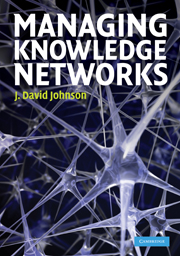Book contents
7 - Spatial distributions of knowledge
Published online by Cambridge University Press: 05 June 2012
Summary
…some bodies of knowledge emerge over time in a process of coevolution with the location in which they are embedded.
(Birkinshaw, Nobel, and Ridderstrale 2002, p. 279)Spatial dimensions of time–space relations are fundamental to most scientific inquiry. However, for a long time the social sciences have been spatially “blind,” unattuned to the effects of distance and positioning on human interaction, but advances in geographic information systems have demonstrated the rich possibilities for visualization by approaching problems spatially. “…spatial structure is now seen not merely as an arena in which social life unfolds, but rather as a medium through which social relations are produced and reproduced” (Gregory and Urry 1985, p. 3). In fact, spatial factors also represent a larger movement in communication and management theory, since some view space as equivalent to context in providing the medium within which social interaction is embedded (Hatch 1987; Pfeffer 1982).
An irreducible fact of human existence is that individuals are located within a physical world. While individual locations in space may be attributable to a number of factors, they provide the basic context within which all communication occurs. Indeed, it has been argued more generally that fixed physical distances between nodes are one source of stability in network structures (Barnett and Rice 1985). As Pfeffer (1982) has pointed out, examination of communication structure and spatial factors serves as a very attractive alternative to traditional approaches to organizational theory.
- Type
- Chapter
- Information
- Managing Knowledge Networks , pp. 122 - 134Publisher: Cambridge University PressPrint publication year: 2009



